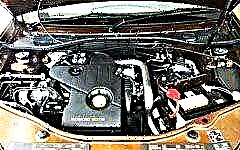

The content of the article:
- History of appearance
- Generation
- Device
- Scheme
- Principle of operation
- Frequent malfunctions
- Pros and cons of the system
Anti-lock braking system, or also known as ABS (Anti-lock braking system) is today considered standard for modern cars from well-known manufacturers. The main purpose of the system is to prevent the vehicle wheels from locking during braking. Thus, the vehicle retains directional stability and controllability. It is worth remembering that in this case, the braking distance may be longer than without using ABS.
When did the ABS system appear?

For the first time, they started talking about the anti-lock braking mechanism back in 1920, when they began to equip aircraft with such a mechanism. The first developments belonged to the French company Avions Vision, a well-known manufacturer of various aircraft and automobiles at that time.
Sixteen years later, Bosch patented the first ABS system that responded to hard braking. It did not come to implementation, since there were no digital technologies that would allow constant control. In the 1960s, the project was resumed again, thanks to the advent of semiconductor technology. The first practical examples of the ABS system appeared in 1971, developed by General Motors.
The first production models began to be installed on cars as an option in the mid-1970s. As a standard set, in 1978 Mercedes introduced ABS for the Mercedes-Benz W116 models (the prototype of the modern S-Class). The baton was instantly picked up by BMW, having installed the 7th series on the model. At the time of the release of the system, its cost was about 10% of the total price of the car. Nowadays, since 2004, all auto manufacturers in Europe have been obliged to install ABS as a standard option, even for the "poorest" configuration.
What were the generations of the anti-lock braking system?

Progress did not stand still and it is understandable that with the development of digital technologies and cars, the anti-lock braking system developed. As already mentioned, 1970 is considered the first generation, when ABS was first created. The performance left us expecting the best, since the drive axle was blocked, and the system mechanism itself did not work for a long time and quickly fell into disrepair.
The second generation came in 1978. Starting this year, the Mercedes-Benz S-Class and BMW 7-Series began installing ABS as a standard option. It should be noted that the efficiency of the mechanism was at its best for those years and showed excellent results. Now the main task of the engineers was to reduce the size and components of the system.

The third generation of the ABS system is distinguished by the release of the new 2E system in 1980. The main difference is that the weight of the hydraulic unit has been reduced to 4.9 kg, up from 6.3 kg. Similarly, the number of elements decreased, instead of 140, there were only 40 elements.
The fourth generation of the anti-lock braking system ABS falls on 1995, when version 5.3 appeared. The next reduction in weight led to indicators of 2.6 kg and 25 components instead of 40. The fifth generation is considered in 2003, with the release of the ABS 8 system. Engineers walked around the first generation in a large circle, the unit weight was 1.6 kg, and the number of elements was 16.
The last sixth generation is in 2010. It is this year that Bosch manufactures ABS, where the hydraulic unit weighs 1.1 kg and the number of elements is only 9 parts. The same year is considered to be the moment of the start of Bosch in the direction of safety systems (active and passive). In all likelihood, in 2020 Bosch will present a modified system, thereby highlighting a new generation. It is assumed that the basis will be only electronics, which can parasitize on the existing mechanisms of the car.
How does the ABS system work?

It makes no sense to consider the device of each generation of the anti-lock braking system. Each generation only complicated the mechanism, so consider the sixth generation of the ABS system. Despite the different cars, brands and models, the ABS device is the same, and the principle of operation is the same. Among the main elements are:
- sensors;
- electronic control unit;
- hydraulic block.
ABS sensors are installed one on each wheel. As a rule, they are responsible for the speed of rotation of the wheels, and the basis of the work is the Hall principle. Sensors are installed on the hub of each wheel. The electronic control unit removes information from them and, on the basis of the data received, determines the moment when the brake system is activated.

The electronic control unit plays a significant role in the operation of the anti-lock braking system. In fact, this is the head of the entire system; the unit collects, analyzes and sends commands to the executive devices. The collection of information, calculations and transmission of commands are ongoing. As a rule, the control unit sends actuating signals to the hydraulic unit and the pump. The hydraulic unit is considered to be the actuator of the anti-lock braking system. The valve body includes an electric magnet with a valve (inlet and outlet), a special hydraulic accumulator, a cam pump, damping chambers and an electric motor. The actuation of each element leads to blocking or unblocking of the wheels of the car.
Diagram of the anti-lock mechanism device

Diagram of the anti-lock braking system ABS
- tank for brake fluid (reservoir);
- brake booster;
- clutch pedal sensor;
- brake pressure sensor;
- ABS control unit;
- receiver;
- wheel shock absorber;
- inlet valve, front left;
- exhaust valve, front left;
- brake cylinder, front right;
- wheel speed sensor.
It should be borne in mind that for each wheel there is an intake and exhaust valve, as well as a brake cylinder and a sensor. These elements are hovered in the diagram, but they are not listed to reduce repetition.
How does the ABS system work?

Having considered what the anti-lock braking system consists of, and its main elements, we will consider the principle of operation. ABS operation is cyclical, each cycle consists of three main phases: increasing the pressure in the braking system, holding the pressure and releasing the pressure. There is an opinion that ABS independently increases the pressure in the braking mechanism, but in fact it is not so and the pressure is increased only with the help of the driver (if we talk about pure ABS, without ESP).
The first step is to increase the pressure by the driver. In this case, the pressure in the braking system increases naturally by pressing the brake pedal by the driver. Typically, the intake valves are open and the exhaust valves are closed. The system reads data from the sensors on the wheels. If the speed of the wheel slows down quickly compared to the programmed data, the ABS control unit moves the inlet valve of the specified wheel to the closed position, while the outlet valve is also in the closed mode.

After closing the inlet valve, the second stage takes place. Having determined which wheel brakes the most, the mechanism disconnects the brake cylinder from its working task, as well as the working circuit of the brake system. It should be understood that even with more intensive pressing of the brake pedal, the pressure in the system will not increase.
The anti-lock braking system independently selects the most effective pressure. The mechanism also controls the speed of rotation of the wheels, until the moment of stabilization or complete stop.In the event that the rotation of the wheels is below the permissible level, the mechanism will automatically open the exhaust valve and release the pressure, thereby completely relieving certain mechanisms from braking.

The last step in the anti-lock braking system is to release pressure. At this stage, the system opens the exhaust valve, due to which the pressure in a certain circuit drops sharply (to a certain wheel or side). The liquid from the outlet cylinder first enters the accumulator, and then, due to the pump, is pumped back into the receiver.
The inlet valve must be closed, otherwise the pump will not work. All this time, the system reads the wheel speed, after stabilization and return to permissible values, the exhaust valve automatically closes. After completing the entire process listed, the inlet valve opens again and the entire cycle begins from the beginning.
This cycle of operation of the anti-lock braking system will be repeated until the wheel rotation is completely stabilized. To understand, in one second, the ABS mechanism can work up to 6 cycles. It is impossible to disable the ABS operation without interfering with the design of the brake mechanism. Disabling ABS can lead to irreparable consequences. The manufacturer originally designed the braking system using this mechanism.
The most common ABS malfunctions

The first sign and probably the most basic, failure of the ABS system is considered a long-term indication on the corresponding icon on the instrument panel. Nevertheless, each breakdown has its own explanation. The problem can be minor, the sensors are clogged, or the wire simply fell off. There may also be a more serious reason - air has entered the system or breakdown of elements. It should be understood that sooner or later even the perfect anti-lock wheel system itself becomes unusable.
As practice shows, experts identify several main and most frequent breakdowns of the anti-lock braking system. First of all, it is worth checking the integrity of the fuses, it is possible that over time they may burn out. Further on the list are wheel rotation sensors on the hubs, as well as weight. Sensors tend to wear out, as they are constantly in operation. The slightest blockage can also lead to failure of the entire mechanism. Do not forget that another reason for the failure of the entire system can be an elementary wire break or damage to individual ABS elements.
Pros and cons of the ABS system

Like any mechanism, anti-lock brakes have their pros and cons. For some, this mechanism is very useful in driving, while others, on the contrary, strive to remove it from the car in every possible way.
| Pros and cons of anti-lock braking system (ABS) | |
| pros | Minuses |
| Keeping the vehicle steerable | Increased stopping distance on soft road surfaces |
| Shorter braking distances on hard surfaces | Broken wheel sensors can cause the brake system to malfunction. |
| Improving the efficiency of the braking process | No way to disable or remove ABS |
| Improving vehicle maneuverability on slippery roads | |
Each driver can highlight their own pros and cons of the anti-lock braking system. Nevertheless, as practice shows, in most cases ABS saves from unpredictable situations, including an accident.
With the advancement of vehicles and safety mechanisms, the anti-lock braking system is also being upgraded. According to various manufacturers, the latest generation of ABS is capable of recognizing the type of road surface. This not only made it possible to avoid errors in the operation of the mechanism on the sand, but also contributed to the development of control mechanisms for the car's suspension. See also how EBD works.











